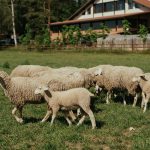When considering fleece fabric, you might find yourself intrigued by its insulation and breathability properties. This lightweight material not only traps warmth but also allows moisture to escape, making it a practical choice for various activities. As you explore the unique structure of fleece, you'll discover how its air pockets enhance ventilation and regulate temperature. But what about its durability and environmental impact? Understanding these aspects could influence your choices in outdoor apparel significantly.
Table of Contents
Key Takeaways
- Fleece fabric provides excellent insulation by trapping warmth and maintaining heat even when wet, making it ideal for cold conditions.
- Its moisture-wicking properties pull sweat away from the skin, keeping users dry and comfortable during physical activities.
- Fleece is lightweight, allowing for easy layering without bulk, enhancing comfort and mobility in various settings.
- The fabric is durable, resistant to pilling and abrasion, ensuring it retains its appearance and quality over time.
Overview of Fleece Fabric
Fleece fabric is a soft, lightweight material known for its warmth and versatility, making it a popular choice for clothing and outdoor gear. You'll find fleece in a variety of products, from jackets and blankets to hats and socks, thanks to its ability to provide comfort without weighing you down. The fabric's unique texture consists of tiny fibers that create a plush surface, which not only feels great against your skin but also helps trap heat.
When you choose fleece, you can expect it to be easy to care for. Most fleece items are machine washable and quick-drying, allowing you to spend more time enjoying your activities and less time worrying about laundry. Additionally, fleece comes in various thicknesses and styles, giving you options to suit different seasons and preferences.
Moreover, fleece is often made from recycled materials, making it an eco-friendly choice for conscious consumers. Its durability ensures that your fleece items will last, resisting wear and tear even after multiple washes.
All these factors contribute to fleece's popularity, making it a staple in both casual and outdoor wardrobes, perfect for your active lifestyle.
Insulation Properties
When it comes to insulation properties, fleece fabric really shines in heat retention capabilities.
It traps warmth close to your body while also managing moisture effectively, keeping you dry and comfortable.
Understanding these features can help you choose the right fleece for your needs.
Heat Retention Capabilities
One of the standout features of fleece fabric is its remarkable ability to trap warmth, making it an excellent choice for insulation in cold conditions. When you wear fleece, you'll notice how effectively it retains heat, wrapping you in a cozy layer of comfort. This is due to the fabric's unique structure, which creates tiny air pockets that capture and hold body heat.
Fleece is lightweight yet incredibly warm, allowing for easy layering without the bulk of heavier materials. Whether you're hiking in chilly weather or lounging at home, fleece helps keep you toasty. You'll also appreciate how quickly it warms up when you put it on, providing immediate relief from the cold.
Another benefit is that fleece can maintain its insulating properties even when wet. Unlike some materials that lose their heat retention capabilities when damp, fleece continues to keep you warm, making it a reliable option for unpredictable weather.
Moisture Management Efficiency
While fleece excels at retaining heat, its moisture management efficiency further enhances its insulation properties, ensuring you stay dry and comfortable in varying conditions.
The fabric's unique structure allows it to wick moisture away from your skin, preventing that clammy feeling that can occur with other materials. This is crucial during activities like hiking or running, where sweat production increases.
When you wear fleece, the moisture is drawn to the fabric's surface, where it evaporates more easily. This process keeps your body temperature regulated, preventing overheating while still offering warmth.
Unlike cotton, which absorbs moisture, fleece keeps you feeling fresh and dry, making it a reliable choice for outdoor adventures.
Moreover, fleece dries quickly, so if you do get caught in the rain or sweat excessively, you won't have to worry about staying damp for long.
The lightweight nature of fleece also contributes to its efficiency, allowing for easy layering without adding bulk.
Whether you're enjoying a chilly morning run or lounging by the fire, fleece's moisture management ensures you can focus on your activity without discomfort.
Breathability Features
Fleece fabric's breathability features allow moisture to escape, keeping you comfortable during both active and relaxed moments. When you wear fleece, you'll notice how it maintains a balance between warmth and airflow. This is especially important when you're engaging in activities like hiking or jogging, where temperature regulation is key.
The unique structure of fleece creates tiny pockets of air that promote ventilation. As you move, these air pockets help circulate air around your body, preventing overheating. You won't feel stifled, even when you're exerting yourself. When you take a break, the breathability ensures you stay comfortable and dry, rather than feeling clammy.
Moreover, fleece is lightweight, which enhances its breathability. You can layer it over other clothing without feeling weighed down. The fabric drapes well, allowing freedom of movement without restricting airflow.
Moisture-Wicking Capabilities
When you're out and about, moisture-wicking capabilities in fleece fabric really matter.
The hydrophobic fiber structure helps pull sweat away from your body, keeping you dry and comfortable.
Plus, the fast evaporation and drying speed ensure you won't stay damp for long, no matter how active you get.
Hydrophobic Fiber Structure
Hydrophobic fiber structures in fleece fabrics effectively repel moisture, keeping you dry and comfortable during outdoor activities. These fibers are engineered to resist water, allowing sweat and rain to bead up and roll off instead of soaking into the fabric. This unique property is crucial for anyone who enjoys hiking, skiing, or camping.
Here are some key features of hydrophobic fibers:
- Water Resistance: They create a barrier against water, preventing saturation.
- Moisture Management: They wick sweat away from your skin, promoting a dry feeling.
- Quick-Drying: While they repel moisture, they also dry rapidly, minimizing discomfort.
- Durability: These fibers maintain their hydrophobic properties through numerous washes, ensuring long-lasting performance.
When you choose fleece with hydrophobic fiber structures, you're investing in comfort and functionality. You can enjoy your outdoor adventures without worrying about dampness, allowing you to focus on what really matters: having fun and exploring the great outdoors.
Evaporation and Drying Speed
Understanding how moisture-wicking capabilities enhance evaporation and drying speed helps you stay comfortable during intense activities.
Fleece fabric is designed to pull moisture away from your skin, allowing sweat to evaporate quickly. This process keeps you dry and reduces the chill that can occur when damp fabric clings to your body.
When you engage in physical exertion, your body temperature rises, causing you to sweat. Fleece's unique hydrophobic fibers absorb this moisture and draw it to the fabric's surface. As the moisture spreads out, it evaporates faster, ensuring you don't feel weighed down by wet clothing. This rapid drying not only enhances your comfort but also helps regulate your body temperature.
Moreover, the lightweight nature of fleece means you won't feel bogged down by heavy, soggy fabric. Instead, you'll experience a soft, warm layer that supports your activities without hindrance.
Durability and Longevity
Fleece fabric boasts impressive durability and longevity, making it a favorite choice for outdoor enthusiasts and casual wearers alike. When you invest in fleece, you're choosing a material that can withstand the rigors of daily wear and tear. Its resilience ensures that it holds up well against various conditions, whether you're hiking, camping, or simply lounging at home.
Here are four key aspects of fleece durability:
- Resistant to Pilling: High-quality fleece is designed to resist pilling, keeping your garments looking new for longer.
- Color Retention: Fleece maintains its color and vibrancy even after multiple washes, so you won't have to deal with fading.
- Tear and Abrasion Resistance: The tightly woven fibers provide excellent resistance to tears and abrasions, ensuring your fleece can handle rugged use.
- Easy Care: Fleece is machine washable and quick-drying, making maintenance a breeze while preserving its quality.
With these qualities, fleece fabric stands out as a reliable option that combines comfort with long-lasting performance, allowing you to enjoy your favorite pieces for years to come.
Environmental Impact
The environmental impact of fleece fabric is an important consideration, especially as consumers become more eco-conscious.
While fleece is often praised for its warmth and lightweight properties, its production can pose environmental challenges. Most fleece fabrics are made from polyester, derived from petroleum, which contributes to fossil fuel depletion and greenhouse gas emissions during manufacturing.
Additionally, when you wash fleece, tiny plastic fibers can shed and enter waterways, contributing to ocean pollution and harming marine life. These microplastics are a growing concern, as they can accumulate in ecosystems and eventually enter the food chain.
However, there are eco-friendly alternatives available. Recycled polyester fleece, made from post-consumer plastic bottles, helps reduce waste and lessen the demand for virgin materials. By choosing fleece made from recycled sources, you can help mitigate some of the negative impacts associated with conventional fleece production.
Ultimately, being mindful of the environmental impact of fleece fabric allows you to make informed choices. Look for brands prioritizing sustainability, and consider how your choices can contribute to a healthier planet while still enjoying the benefits of this versatile material.
Care and Maintenance Tips
Taking care of your fleece fabric properly can prolong its lifespan and maintain its quality, ensuring you get the most out of your eco-friendly choices. Here are some essential care and maintenance tips to keep your fleece looking great:
- Wash Gently: Always opt for a gentle cycle in cold water. Avoid fabric softeners, as they can reduce breathability and moisture-wicking properties.
- Air Dry: Instead of tossing your fleece in the dryer, let it air dry. High heat can cause it to lose its shape and softness.
- Store Properly: When storing your fleece, fold it neatly instead of hanging. This prevents stretching and preserves its structure.
- Avoid Sharp Objects: Be cautious around sharp objects that could snag the fabric. If you do get a snag, trim it carefully with scissors to avoid further damage.
Frequently Asked Questions
Can Fleece Fabric Be Used for Outdoor Activities?
Yes, you can definitely use fleece fabric for outdoor activities. It's lightweight, warm, and dries quickly, making it great for hiking, camping, or any adventure. Just ensure you layer appropriately for varying weather conditions.
Is Fleece Fabric Hypoallergenic for Sensitive Skin?
Fleece fabric isn't inherently hypoallergenic, but many people with sensitive skin tolerate it well. Just make sure you choose high-quality fleece and avoid harsh chemicals during production to minimize potential irritants for your skin.
What Are Common Uses for Fleece Fabric Beyond Clothing?
You'll find fleece fabric used in blankets, throws, pet beds, and outdoor gear. It's popular for home decor items like pillows and rugs, as well as in crafting projects due to its versatility and comfort.
How Does Fleece Compare to Wool in Performance?
When you compare fleece to wool, you'll find fleece is lighter and dries faster, while wool offers superior moisture-wicking and odor resistance. Each has strengths depending on your activity and environmental needs.
Are There Different Types of Fleece Fabric Available?
Yes, there are several types of fleece fabric available. You'll find options like microfleece, polar fleece, and high-loft fleece, each offering unique textures and warmth levels, perfect for various activities and weather conditions.
- How Does Ring Spun Cotton Affect Garment Fit and Shape Retention? - August 13, 2024
- What Are the Challenges in Producing Ring Spun Cotton? - August 13, 2024
- Is Ring Spun Cotton Suitable for Plus-Size Clothing? - August 13, 2024






